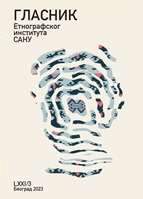The Motif of the “Lost Paradise” in Blockbuster Films Set in the Post-Apocalypse
The Motif of the “Lost Paradise” in Blockbuster Films Set in the Post-Apocalypse
Author(s): Sonja Žakula, Uroš MatićSubject(s): Sociology of Culture, Film / Cinema / Cinematography, Sociology of Art, History of Art
Published by: Етнографски институт САНУ
Keywords: myths; post-apocalyptic science fiction; Anthropocene; naturecultures;
Summary/Abstract: Considering that mythology and storytelling are an integral part of the human experience, in this paper we will take a look at contemporary iterations of certain archetypal myths. While the authors do not espouse the idea that “science fiction is the mythology of modern society”, we believe that there is something to be said about popular culture as a medium of narrative transmission in post-industrialist society. In this sense, the paper analyses the utilization of origin myths in post-apocalyptic science fiction movies: Waterworld (1995), The Matrix franchise (four installments 1999–2021), Wall-E (2008), the Mad Max franchise (four installments 1979–2015), among others. Common to all of these narratives is that they are set after a global catastrophe that frames the “Earth before” as a paradise that was lost due to human agency. Some of these narratives also feature a search for the remnants of that lost world (most notably Waterworld and Mad Max: Fury Road), as well as “lesser” origin myths that pertain to groups of survivors themselves (e.g. Mad Max: Beyond Thunderdome). In the context of current debates on the Anthropocene, an era rapidly leading towards a global catastrophe, and following Donna Haraway’s work on storytelling, we believe that the act of telling these stories, and the ways in which they are told is of vital importance if we, as a species, are to survive. Furthermore, post-apocalyptic science fiction offers not only a warning but also possible outcomes exemplified through new, emerging and different naturecultures. These naturecultures range from the emergence of new and better adept bodies of a minority (which triggers stigma), to bodies which are increasingly dependent on other actants, e.g., AI. We argue that within the genre of science fiction these novel postapocalyptic naturecultures are framed as imperfect, and that such framing strengthens the myth of Earth before the apocalypse as a lost paradise. Consequently, posthumanist bodies are seen in a Biblical manner as bodies “after the Fall”, rather than as bodies which have not only the potential to survive but also to prevent the catastrophe.
Journal: Гласник Етнографског института САНУ
- Issue Year: LXXI/2023
- Issue No: 3
- Page Range: 117-136
- Page Count: 20
- Language: English

